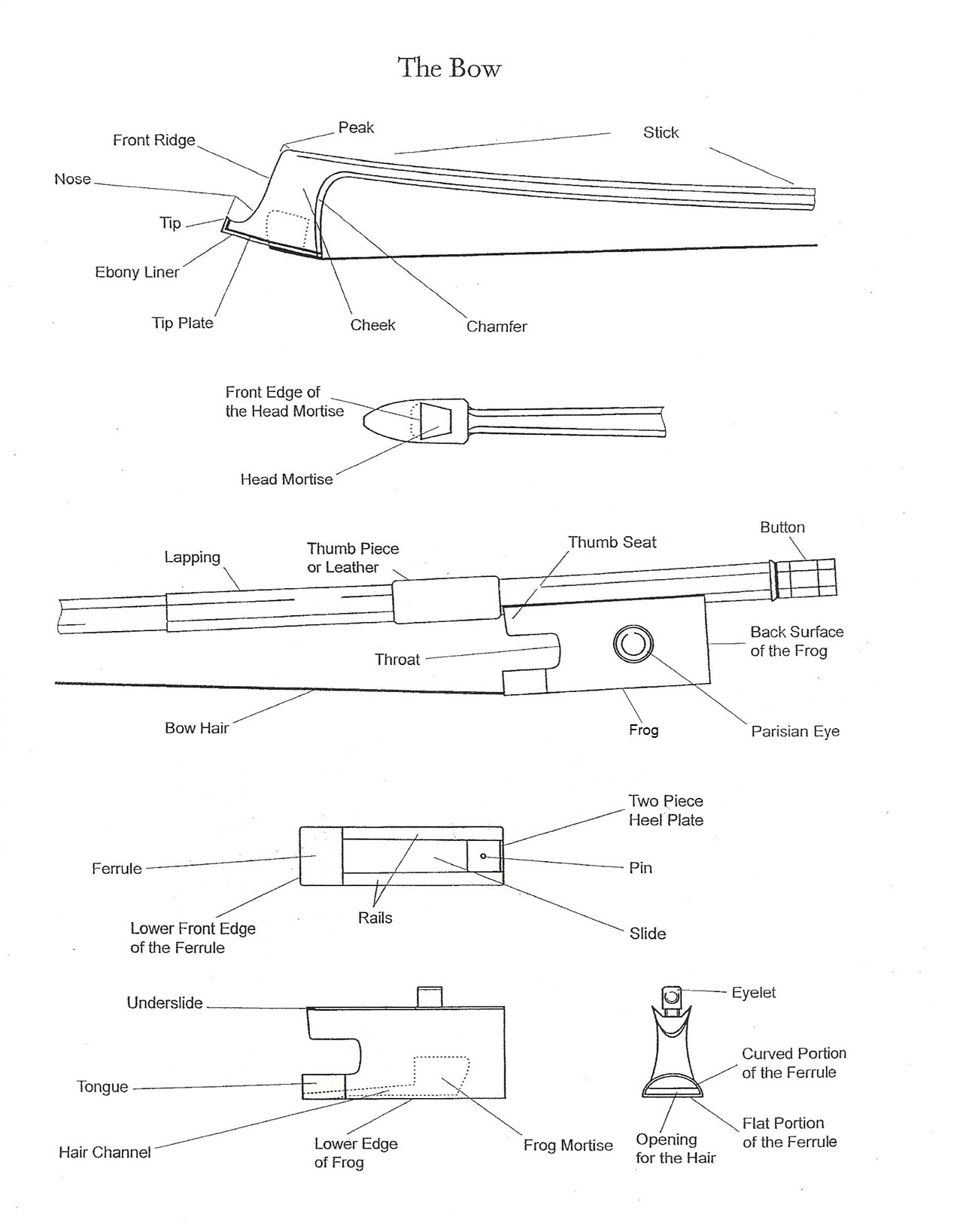Anatomy of a Bow – The Ultimate Guide to Violin Bows
From classical music to Bluegrass fiddling and many genres in between and beyond, bowed string instruments such as violins, violas, and cellos are incredibly versatile in their capacity to create diverse tone, rhythm, and a wide range of melodic phrasing within and across genres. Although variations in weight, length, shape and size are specific to each type of bowed string instrument, modern violin, viola, cello, and bass bows are very similar in their basic construction. Understanding the anatomy of the bow will help strings players care and maintain their bow and choose the right bow for their playing. Let’s explore the anatomy of the bow and how each part works together to form a functioning whole.
The Parts of a Bow & How They Work Together
Each violin, viola, cello or bass bow is unique, and there are wider variations particularly when looking at early bows such as those from the Baroque period of music. However, all modern bows have the following parts- the stick, hair, tip, tip plate, frog, ferrule, screw (button) winding (lapping), and thumb leather. Let’s take a look at each part in more detail.
To begin, we have the bow stick. The stick of a modern bow is curved inward and must have a natural balance point about 1/4 of the length of the stick from the frog end. It must be flexible enough to respond to the changes in pressure applied by the player as the bow is drawn across the string. The stick is usually made of wood, though carbon fiber bows are becoming more popular. The wood considered to be the most high-quality for bow-making is Pernambuco wood (Paubrasilia echinata), sourced from the heart of the Pernambuco tree, a species native to Brazil. More inexpensive bows are often made from wood from the outer part of the tree, as well as from other tropical trees known generally as “Brazilwood.”
However, due to issues of sustainability as well as affordability, carbon fiber is also growing in popularity for its sustainability and durability, and unlike its much cheaper fiberglass cousin (which is very rigid and makes advanced playing techniques nearly impossible), carbon fiber is extremely strong, durable and flexible and able withstand changes in humidity and heat.
Next, let’s discuss the hair of the bow. Bow hair is usually made from horsehair, though synthetic hair is available. Horsehair from Mongolian and Siberian horses is most preferred as it is believed that horses native to cold climates have the thickest and strongest hair. Different colors of hair can be used to create more or less attack – the reason being that darker horsehair is thicker and coarser than lighter hair. White or ivory-colored hair is most common, but bassists, cellists and folk players such as fiddlers may prefer black for its capacity for more aggressive sound. There is even “salt and pepper” hair that is a customizable mixture of black and white hair to allow for precision between grip and subtlety.
It is the coarseness of any type of bow hair, augmented by the application of rosin, that creates friction as the bow is drawn across the strings of the instrument, grabbing onto and then releasing the surface of the strings and causing the vibration resulting in sound. Regular maintenance of the bow includes replacing the hair. Bow hair becomes dirty and worn overtime, losing optimal friction, and its high susceptibility to changes in humidity with the seasons can cause it to stretch and shrink, which if not carefully avoided can cause damage to the stick, eyelet, screw and winding of the bow as a player attempts to maintain the correct tension of bow hair for playing with hair that has become too tight or slack.
You probably know that the bow hair is connected to the bow stick at each end. These ends have specific construction. First, at the end of the bow opposite from where the bow is held by the player, you will find the tip and the tip plate. The tip is where the hair connects to the stick of the bow at this end. It must be carefully crafted and should not be too light or too heavy as a too light tip will not produce sound as this end of the bow makes contact with the strings and too heavy of a tip will be cumbersome and make for uneven playing. Either problem will compromise the structural integrity of the bow as well as impede its playability. A tip plate, usually made from synthetic materials, metals, or animal materials such as mammoth or camel bone, is a protective cover of the tip.
On the other end of the bow, the frog, often made from ebony wood, is where the player holds the bow. It serves a dual purpose: creating space between the hair and the stick so that the stick can have an inward curve without the hair contacting it (deadening the sound) and it holds the mechanism for tightening and releasing the bow hair. Inlaid in the frog there is often an “eye” (a dot of pearl, silver, shell or other material) or other kinds of decorative inset materials.
At the bottom of the frog, there is a removable plate of metal. This is called the ferrule and it is used to protect the joining of the bow hair to the frog.
The screw or button is found at the bottom end of the bow stick opposite the tip. This is used to loose and tighten the bow hair.
A metal winding or “lapping” (usually made from nickel, silver, tinsel, faux whalebone, or even gold) and a piece of leather or other type of animal or synthetic material known as the thumb leather sit just above the frog and serve to protect the stick of the bow from the wear of the player’s hand as well as to make the bow more comfortable to hold. These materials must be carefully considered as the weight of the winding in particular has an effect on the balance of the bow.
How Does All This Affect Your Music?
A bow that is made from high-quality materials will be more durable and responsive to your playing techniques. A bow that is improperly balanced will be difficult to play. Using the screw, you can adjust the bow hair’s tension for different playing techniques and desired sound, although it is important not to tighten too much so that the stick becomes warped and inflexible from tension or so loosely that the bow hair makes contact with the stick of the bow. Regular maintenance is essential to protect your investment and ensure you get the best out of your violin, viola, or cello.



